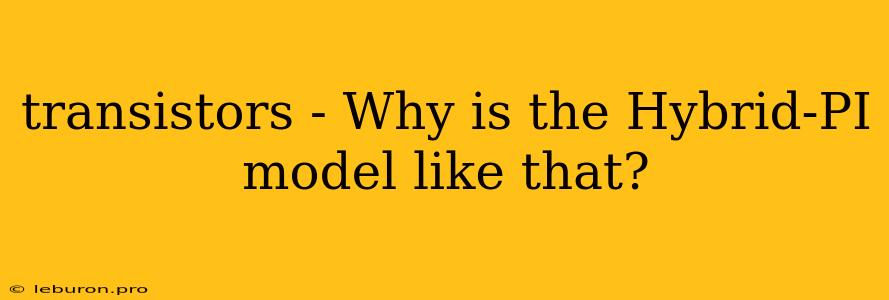The Hybrid-PI model is a widely used small-signal model for Bipolar Junction Transistors (BJTs). It is a highly accurate model that captures the essential electrical characteristics of the transistor, making it suitable for circuit analysis and design. This model is particularly useful for analyzing the high-frequency behavior of BJT circuits, where other simpler models might not provide accurate results. However, the complexity of the Hybrid-PI model can be intimidating, leaving many wondering why it is structured the way it is. This article aims to delve deeper into the reasoning behind the structure of the Hybrid-PI model, exploring the various elements and their connection to the internal workings of the BJT.
Understanding the Components of the Hybrid-PI Model
The Hybrid-PI model represents the BJT as a combination of linear elements, including resistors, capacitors, and current sources. These elements are carefully chosen to reflect the various physical processes occurring within the transistor, such as:
- Base-emitter junction capacitance (Cbe): This capacitance represents the charge stored in the depletion region of the base-emitter junction. It accounts for the junction's capacitance and is influenced by the applied voltage.
- Base-collector junction capacitance (Cbc): Similar to Cbe, this capacitance represents the charge stored in the depletion region of the base-collector junction and is also voltage-dependent.
- Internal base resistance (rb): This resistance represents the inherent resistance of the base region, which influences the current flow within the base.
- Transconductance (gm): This parameter represents the relationship between the collector current and the base-emitter voltage. It quantifies how effectively the base current controls the collector current.
- Output resistance (ro): This resistance accounts for the finite output impedance of the collector-emitter junction, which impacts the voltage drop across the junction.
- Early voltage (VA): This parameter represents the voltage at which the collector current becomes infinite in the output characteristic curves. It essentially quantifies the slope of the output characteristics, contributing to the output resistance.
- Collector-emitter capacitance (Cce): This capacitance represents the capacitance between the collector and emitter terminals, primarily arising from the depletion region of the base-collector junction.
Rationale Behind the Model Structure
The structure of the Hybrid-PI model is derived from the fundamental physics of transistor operation. The core idea is to break down the complex behavior of the BJT into simpler, linear components that can be easily analyzed using circuit theory.
The Pi-Network and its Significance
The core of the model is a pi-network consisting of Cbe, Cbc, and gm. The pi-network captures the dynamic behavior of the BJT, representing the relationship between the base-emitter voltage and the collector current.
- Cbe represents the capacitance associated with the base-emitter junction, which contributes to the high-frequency limitations of the transistor.
- Cbc accounts for the capacitance associated with the base-collector junction, which also contributes to high-frequency limitations, especially in common-emitter configurations.
- gm embodies the transconductance of the BJT, representing the relationship between the input voltage and the output current. This element is essential for understanding how the transistor amplifies signals.
Incorporating the Remaining Components
- rb accounts for the base region's inherent resistance, which can affect the base current and ultimately the collector current.
- ro represents the output resistance of the BJT, which signifies the transistor's ability to maintain a constant output voltage under varying load conditions. It arises from the Early effect, which essentially describes the relationship between the collector current and the collector-emitter voltage.
- Cce accounts for the capacitance between the collector and emitter terminals, which can influence the high-frequency performance of the transistor. It primarily originates from the depletion region of the base-collector junction, especially in common-emitter configurations.
Importance of the Hybrid-PI Model
The Hybrid-PI model is a crucial tool for understanding and predicting the behavior of BJTs in various circuit configurations. It allows engineers to:
- Analyze high-frequency performance: The model accurately represents the capacitances and resistances that contribute to the transistor's frequency response, allowing for accurate prediction of high-frequency limitations.
- Design amplifier circuits: The model enables the calculation of gain, bandwidth, and other critical amplifier parameters, facilitating the design of high-performance amplifiers.
- Simulate transistor behavior: The model serves as a foundation for sophisticated circuit simulators, enabling the simulation of complex BJT circuits and the optimization of their performance.
Conclusion
The Hybrid-PI model, despite its seeming complexity, is a powerful tool for analyzing and understanding the behavior of BJTs. Its structure, with its combination of linear elements, effectively captures the intricate physical processes occurring within the transistor. The model's emphasis on the pi-network, representing the dynamic behavior of the BJT, along with the inclusion of internal resistances, output resistances, and capacitances, enables accurate predictions of transistor behavior across various operating conditions and frequencies. Its importance in analyzing high-frequency performance, designing amplifier circuits, and simulating transistor behavior underscores its indispensable role in modern electronics engineering.
